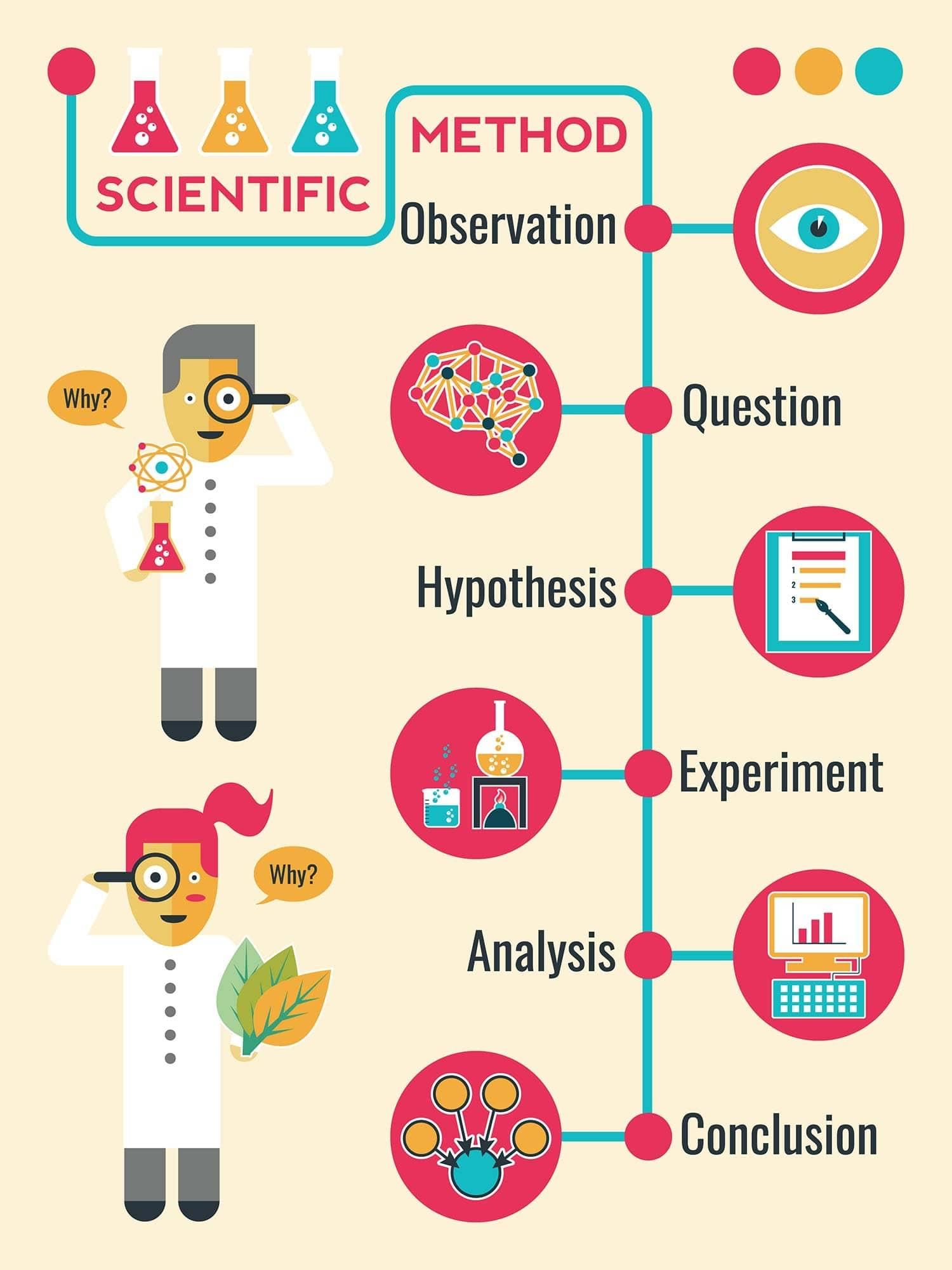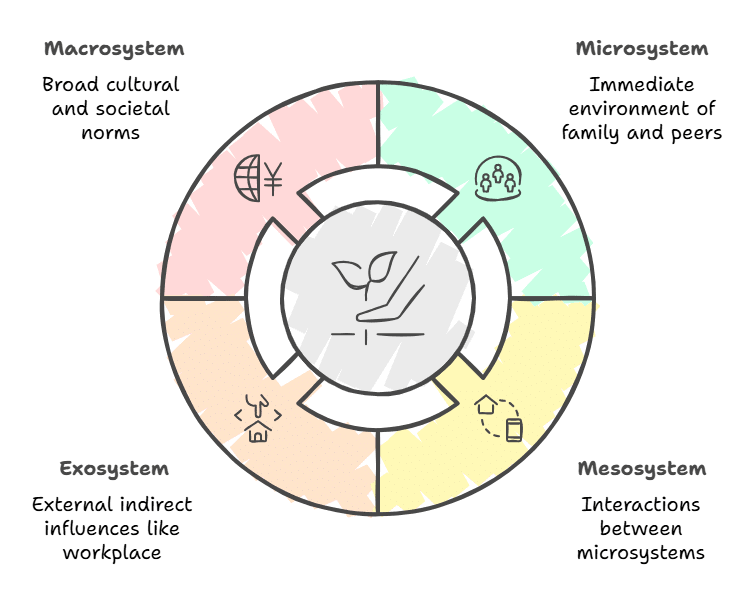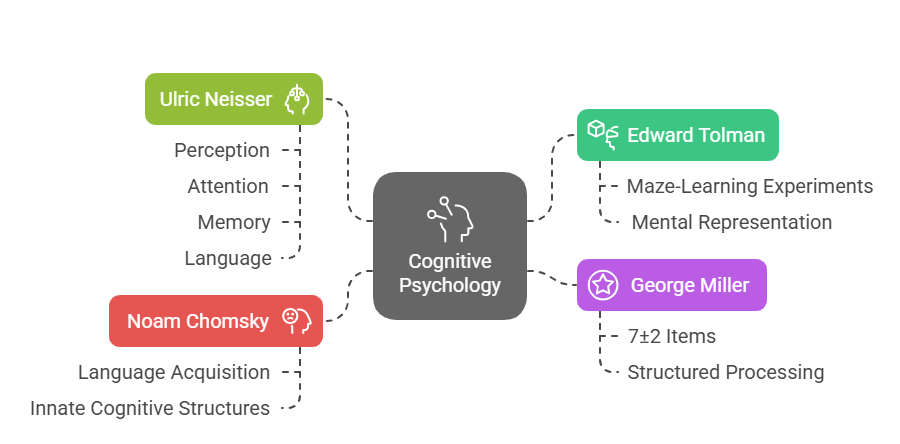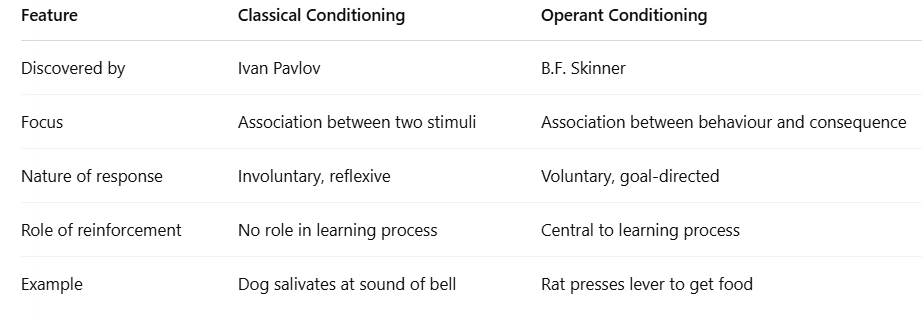UPSC Mains Answer PYQ 2024: Psychology Paper 1 (Section- A) | Psychology for UPSC Optional (Notes) PDF Download
Question 1
Answer the following questions in about 150 words each
(a) What makes psychology a science? Discuss
Ans: Psychology is considered a science due to its reliance on systematic and empirical methods to understand and explain human behaviour and mental processes. It employs the scientific method, which involves observing, hypothesizing, experimenting, and drawing conclusions based on empirical evidence. For example, B.F. Skinner's experiments on operant conditioning involved systematic observation and controlled environments to study behaviour, illustrating the use of scientific methodologies in psychology. Psychology is also replicable, meaning that its experiments can be repeated and yield similar results, such as Pavlov's classical conditioning experiments. This ensures objectivity and reliability. Moreover, predictability in psychology is evident through theories like reinforcement theory, which predicts future behaviour based on past reinforcement. Finally, psychology as a science is self-correcting, where new evidence leads to the revision of existing theories, as seen in Piaget's evolving theory of cognitive development. Thus, psychology combines empirical research, experimentation, and theory-building, characteristics central to the scientific process.
(b) Citing relevant examples, explain independent, dependent and mediating variables.
Ans: In psychological research, understanding the relationship between variables is critical.
Independent Variable (IV): The variable that is manipulated or changed by the researcher. For example, in a study on sleep and memory, the amount of sleep (e.g., 4 hours vs. 8 hours) is the independent variable.
Dependent Variable (DV): The outcome that is measured in response to the changes in the independent variable. In the sleep-memory study, the number of correct answers on a memory test would be the dependent variable.
Mediating Variable (MV): A variable that explains the process through which the independent variable affects the dependent variable. For instance, stress could be a mediating variable; inadequate sleep increases stress, which then affects memory performance.
These variables help researchers understand how changes in one factor (IV) lead to changes in another (DV), and the underlying processes (MV) that contribute to this effect. By identifying and measuring these variables, psychologists can design experiments that clarify cause-and-effect relationships.
c) Describe data collection methods in psychology with special reference to observation and survey methods.
Ans: Data collection in psychology involves gathering information systematically to understand human behaviour.
Observation Method: This involves watching and recording behaviours in natural or controlled settings.
1. Naturalistic Observation: Behaviour is observed in its natural environment without interference. For example, observing children playing in a playground.
2. Controlled Observation: The researcher sets up a controlled environment to observe specific behaviours, such as lab experiments.
While observational methods provide high ecological validity, they can suffer from observer bias and lack of control over variables. Psychological Inquiry
Psychological InquirySurvey Method: This method collects data through questionnaires or interviews, providing insights into attitudes, opinions, and self-reported behaviours. For example, surveys measuring job satisfaction use Likert scales to quantify responses.
Surveys allow data collection from large samples, but they may face issues like social desirability bias, where respondents give answers they believe are socially acceptable rather than truthful.
Both methods have strengths and weaknesses and are often combined in research to offer a comprehensive understanding of human behaviour.
(d) Differentiate between growth and development. Explain the principles of life span development in the context of developmental ecology.
Ans : Growth refers to quantitative changes, such as an increase in size, height, and weight, primarily during early childhood. Development, however, involves qualitative changes, including cognitive, emotional, and social maturation, across the entire lifespan. Growth is more physical, whereas development encompasses broader dimensions like psychological and social changes.
The principles of life span development, as outlined by Paul Baltes, include:
Multidirectionality: Development involves both growth and decline in various aspects (e.g., cognitive decline in old age and emotional maturity in adulthood).
Plasticity: The potential for development to change at any age (e.g., cognitive abilities can improve through practice at any stage of life).
Multidimensionality: Development involves changes across various domains—cognitive, emotional, and physical.
Historical Context: Development is influenced by societal and cultural factors, such as historical events or cultural norms.
Lifelong Process: Development is continuous throughout life, not limited to childhood or adolescence.
Developmental Ecology, as per Bronfenbrenner, posits that human development is shaped by multiple systems, including:
Microsystem (family, peers),
Mesosystem (interaction between microsystems),
Exosystem (external indirect influences like parent’s workplace),
Macrosystem (broad cultural and societal norms).
These systems work together, influencing individual development throughout the lifespan.
(e) How do the principles of classical conditioning help in the formation of likes and preferences? Discuss.
Ans: Classical conditioning, proposed by Ivan Pavlov, explains how emotional responses such as likes and preferences are formed through the association of stimuli.
In classical conditioning, a neutral stimulus (NS), when paired with an unconditioned stimulus (UCS) that naturally elicits an unconditioned response (UCR), can lead to the neutral stimulus becoming a conditioned stimulus (CS) that elicits a conditioned response (CR). For example, a person may develop a preference for a particular song (NS) if it is frequently played while eating chocolate (UCS), which causes feelings of pleasure (UCR). Over time, the song alone (CS) can trigger the same positive emotions (CR), creating a preference for it.
In advertising, this principle is often used, where a product (NS) is paired with visually appealing imagery or music (UCS) that elicits positive emotions (UCR). Over time, the product (CS) evokes positive feelings (CR), influencing consumer preferences.
Classical conditioning also explains why we may generalize our preferences. For instance, liking one type of chocolate may lead to an increased preference for other products from the same brand. Thus, classical conditioning helps shape emotional responses, including likes and preferences, through learned associations.
Question 2
(a) Describe the diversity in the disciplinary thoughts with special reference to structuralism, functionalism and behaviourism.
Ans: Psychology has evolved through multiple schools of thought, each contributing a distinct framework to understand human behaviour. The progression from structuralism to behaviourism illustrates the growing scientific orientation of psychology.
Structuralism
Founded by Wilhelm Wundt and further developed by Edward Titchener.
Focused on breaking consciousness into basic elements: sensations, images, and feelings.
Relied on introspection as a method of study.
Limitation: Too subjective, lacked reliability and external validity.
Functionalism
Championed by William James, influenced by Darwin’s evolutionary theory.
Emphasized the purpose (function) of mental processes in helping individuals adapt to their environments.
Broadened psychology’s scope by including emotions, habits, and consciousness.
Adopted more pragmatic and applied approaches compared to structuralism.
Behaviourism
Initiated by John B. Watson and expanded by B.F. Skinner.
Argued that only observable behaviour should be studied scientifically.
Rejected introspection and mentalism.
Key contributions:
Classical Conditioning – Pavlov: Association between stimuli.
Operant Conditioning – Skinner: Behaviour shaped by reinforcement and punishment.
Criticised for ignoring internal cognitive processes, which later led to the cognitive revolution.
These schools represent a diversity of thought in terms of:
Methodology (introspection vs. observation),
Subject matter (mental processes vs. observable behaviour),
Goals (understanding structure vs. function vs. behavioural control).
Each has left a lasting imprint, paving the way for modern, integrative approaches like cognitive and humanistic psychology.
(b) Citing relevant examples, explain independent, dependent and mediating variables. (10 marks)
Ans: Cognitive psychology emerged in the mid-20th century, largely as a response to the limitations of behaviourism. While behaviourism focused on observable stimuli and responses, cognitive psychology emphasized the internal mental processes underlying behaviour.
Foundations of Cognitive Psychology:
Edward Tolman’s cognitive maps (1948): Demonstrated through maze-learning experiments with rats that learning is not just stimulus-response but involves mental representation.
George Miller (1956): Identified the limits of short-term memory (7±2 items), emphasizing the structured nature of cognitive processing.
Noam Chomsky’s critique of Skinner (1959): Argued that language acquisition cannot be explained solely through reinforcement and needs innate cognitive structures (e.g., universal grammar).
Ulric Neisser (1967): Coined the term "Cognitive Psychology" and systematically outlined the study of perception, attention, memory, and language.

Key Features:
Focus on processes like attention, perception, memory, language, reasoning, and problem-solving.
Use of experimental methods and information processing models, often drawing analogies between the human mind and computers.
Emphasis on mental representations and cognitive schemas.
Advancements:
Cognitive neuroscience integrated cognitive theories with brain imaging techniques (like fMRI, PET).
Applications in AI, human-computer interaction, and cognitive therapies.
Cognitive psychology reintroduced the study of the mind in scientific psychology, combining rigorous empirical methods with a focus on how humans think, learn, and remember.
(c) Explain the assumptions of two-way ANOVA. With the help of an example, illustrate main and interaction effects.
Ans: Two-way ANOVA (Analysis of Variance) is used when a study involves two independent variables (factors), each with two or more levels, and one dependent variable. It tests the main effects of each factor and their interaction effect on the dependent variable.
Assumptions of two-way ANOVA:
Independence of observations: Each participant’s data should be independent of others.
Normality: The dependent variable should be approximately normally distributed within each group.
Homogeneity of variances: The variance among groups should be roughly equal (Levene’s test is often used to check this).
Random sampling: The data should be collected using a random sample from the population.
Main Effects: The independent effect of each factor on the dependent variable.
Interaction Effect: Occurs when the effect of one factor depends on the level of the other factor.
Example: A psychologist wants to study the effect of type of instruction (Traditional vs. Digital) and study time (1 hour vs. 2 hours) on test performance.
Main effect of instruction: Whether Traditional vs. Digital methods lead to different performance overall, regardless of study time.
Main effect of study time: Whether 1 hour vs. 2 hours impacts scores, regardless of the teaching method.
Interaction effect: Whether the effectiveness of the teaching method varies based on study time. For instance, Digital may outperform Traditional only at 2 hours, not at 1 hour.
When significant, interaction effects often lead to more meaningful interpretations than main effects alone, revealing the complexity of real-world psychological phenomena.
Question 3
(a) Discuss the signal detection theory (SDT) with reference to perceptual vigilance task performance.
Signal Detection Theory (SDT) is a psychological framework used to explain how decisions are made under conditions of uncertainty. It separates an individual’s perceptual ability (sensitivity) from their decision-making bias (response criterion), making it particularly useful in vigilance and attention studies.
Core Concepts of SDT:
Signal: The target or stimulus the observer must detect.
Noise: Irrelevant or distracting stimuli present in the environment.
Hits: Correct detection of a signal.
Misses: Failure to detect a signal.
False alarms: Detecting a signal when none is present.
Correct rejections: Correctly identifying that no signal is present.
The observer’s performance depends on:
Sensitivity (d′): The ability to distinguish signal from noise.
Response criterion (β): The threshold or bias the observer uses to decide whether a signal is present.
Application to Perceptual Vigilance Tasks:Perceptual vigilance refers to sustained attention where a person monitors a stimulus field for infrequent and unpredictable events over time—like air traffic control or quality checks on an assembly line.
Over time, vigilance decrement occurs—performance declines due to fatigue, boredom, or reduced sensitivity (d′).
Individuals often adjust their response criterion (β) under fatigue or pressure, which can lead to more misses (conservative bias) or more false alarms (liberal bias).
Example: In a radar monitoring task, an operator must detect a blip (signal) among static (noise). As time passes, the operator may miss actual threats (misses) or overreact to irrelevant stimuli (false alarms), especially if under cognitive load.
SDT explains this by showing how both perceptual sensitivity and decision-making thresholds influence performance. This model is crucial in designing better human-machine systems, training modules, and work-rest cycles to improve vigilance-based tasks.
(b) Does punishment work in all situations? Discuss the pros and cons of punishment.
Ans: Punishment is a method used in behaviour modification to decrease the likelihood of a behaviour recurring. While it can be effective in certain situations, its utility depends on how, when, and where it is applied.
Types of Punishment:
Positive punishment: Adding an unpleasant stimulus (e.g., scolding a child).
Negative punishment: Removing a desired stimulus (e.g., taking away screen time).
Pros of Punishment:
Immediate suppression: Can quickly stop dangerous or undesirable behaviours (e.g., stopping a child from running onto the road).
Clear feedback: Teaches the individual about the boundaries of acceptable behaviour.
Can enhance learning: When paired with reinforcement for alternative behaviour (e.g., punishing cheating while rewarding honesty).
Cons of Punishment:
Suppresses, doesn't teach: Punishment tells what not to do, but doesn't guide what to do instead.
Emotional side effects: Can lead to fear, anxiety, aggression, or resentment.
Temporary effect: Behaviour may return once the threat of punishment is removed.
Modeling aggression: Increases the chance of aggressive behaviour, especially in children exposed to harsh physical punishment.
Effectiveness conditions:
Consistency, immediacy, and fairness enhance effectiveness.
Should be mild and paired with reinforcement for desired behaviour.
Example: In school settings, scolding a child for speaking out of turn may stop the behaviour temporarily, but using reinforcement for raising hands is more sustainable.
Hence, punishment can work only when applied judiciously, ethically, and alongside positive reinforcement. Otherwise, it risks producing more harm than benefit.
(c) Is reconstructed memory accurate? Describe the process of reconstruction, citing research evidence.
Ans : Memory is not a perfect recording of events but a reconstructive process. This means that when we recall something, we don’t retrieve it exactly as it happened but instead rebuild the memory using fragments and schemas—often filling in gaps unconsciously.
Reconstructive Process:
Memory retrieval is influenced by schemas—mental frameworks shaped by experience and culture.
Gaps in memory are filled in with plausible inferences, sometimes leading to distortion.
Post-event information can alter original memories (e.g., through leading questions or suggestion).
Key Research Evidence:
Elizabeth Loftus’ studies on eyewitness memory: Showed that language used in questioning influenced recall. In one study, participants who heard “How fast were the cars going when they smashed?” estimated higher speeds than those who heard “hit”.
Loftus & Palmer (1974): Found that participants recalled non-existent broken glass after being exposed to leading words, showing memory distortion.
Bartlett’s “War of the Ghosts” (1932): Participants reconstructed unfamiliar stories using their cultural schemas, often omitting or altering details to fit their understanding.
Accuracy of Reconstructed Memory:
Can be reasonably accurate in general outline.
However, specific details are often distorted, especially under stress, suggestion, or time delays.
Memory is most vulnerable when individuals are confident but exposed to misinformation.
Applications: Understanding reconstruction is crucial in legal settings, especially in evaluating eyewitness testimonies, and in therapy, where false memories can sometimes emerge.
Thus, memory is not a literal playback but a dynamic, constructive process subject to distortion—highlighting both its power and its limitations.
Question 4
(a) Differentiate between classical and operant conditioning. Discuss their applications with suitable examples.
Ans : Classical and operant conditioning are two major learning paradigms within behavioural psychology. Both explain how behaviour can be acquired or modified through associations, but they differ in process and principles.
Differences Between Classical and Operant Conditioning:
Applications:
Classical Conditioning Applications:
Phobias: Fears can develop when a neutral stimulus becomes associated with a frightening event (e.g., Little Albert experiment by Watson & Rayner).
Advertising: Brands associate their products with positive emotions using attractive stimuli (music, celebrities).
Operant Conditioning Applications:
Education: Rewarding good academic performance with praise or tokens encourages desired learning behaviours.
Behaviour modification: Token economies in psychiatric settings or prisons use reinforcement to encourage adaptive behaviour.
Example: In a classroom, a teacher clapping (neutral stimulus) before giving candy (unconditioned stimulus) makes children excited (unconditioned response). Eventually, clapping alone triggers excitement—classical conditioning. On the other hand, rewarding a child for completing homework (positive reinforcement) strengthens the habit—operant conditioning.
Thus, while both forms of conditioning are learning processes, classical conditioning emphasizes associative learning between stimuli, whereas operant conditioning focuses on the consequences of behaviour. Their applications span therapy, education, parenting, and social learning settings.
(b) How do various monocular and binocular cues help us with depth perception? Discuss with the help of examples.
Ans: Depth perception allows us to judge the distance and three-dimensionality of objects in our environment. This is achieved through monocular cues (using one eye) and binocular cues (using both eyes), which the brain integrates to form a coherent spatial understanding.
Monocular Cues: These cues are effective even when viewing with one eye.
Relative Size: Objects that appear smaller are perceived as farther away.
Example: A car farther down the road looks smaller.Interposition (Overlap): When one object blocks another, the blocked object is perceived as more distant.
Example: A person standing in front of a wall appears closer.Linear Perspective: Parallel lines converge as they recede into the distance.
Example: Railway tracks seem to meet at a point on the horizon.Texture Gradient: Closer objects have more detailed textures.
Example: Leaves on a nearby tree look sharper than those on a distant one.Motion Parallax: Nearby objects move faster across our visual field than distant ones when we move.
Example: Trees zoom past in a moving car while distant mountains move slowly.
Binocular Cues: These require both eyes and involve physiological mechanisms.
Retinal Disparity: Each eye receives a slightly different image; the brain uses this difference to calculate depth.
Example: Holding a finger in front and alternately closing eyes shows displacement.Convergence: Eyes turn inward when focusing on a close object; the brain uses the degree of convergence to judge distance.
Example: Bringing a pen tip closer to the nose increases eye convergence.
Together, these cues help us navigate environments, catch objects, drive safely, and perform tasks requiring spatial awareness.
(c) Differentiate between the processes of memory and forgetting. Also, discuss multistore model and meta-memory as innovations in the study of memory.
Ans: Memory refers to the mental processes of encoding, storing, and retrieving information. It allows individuals to retain experiences, knowledge, and skills. Forgetting, on the other hand, is the failure to recall information previously stored in memory. It can result from decay, interference, or retrieval failure.
While memory enables learning and adaptation, forgetting is also essential as it prevents cognitive overload by discarding irrelevant or outdated information. Thus, both processes are part of normal cognitive functioning.
The multistore model of memory, proposed by Atkinson and Shiffrin in 1968, brought a structural perspective to memory. It described memory as consisting of three stages:
Sensory memory, where information from the environment is briefly held.
Short-term memory (STM), which has limited capacity and duration, allowing brief retention and manipulation.
Long-term memory (LTM), where information can be stored indefinitely after adequate encoding and rehearsal.
This model emphasized the process of rehearsal as a key mechanism for transferring data from STM to LTM and encouraged research on memory stages and processes.
Meta-memory refers to a person’s knowledge and awareness of their own memory abilities and strategies. It includes:
Awareness of what one knows and does not know.
Use of strategies like mnemonic devices, chunking, or self-testing to improve memory performance.

Meta-memory plays a crucial role in academic settings, where learners self-assess and plan their study methods accordingly. It is also useful in cognitive therapy and training for older adults or individuals with memory deficits.
These innovations shifted focus from a passive to a dynamic view of memory, considering how information is monitored, controlled, and optimized in real-life tasks.
|
160 videos|215 docs
|
FAQs on UPSC Mains Answer PYQ 2024: Psychology Paper 1 (Section- A) - Psychology for UPSC Optional (Notes)
| 1. What are the key topics covered in Psychology Paper 1 of the UPSC Mains Exam? |  |
| 2. How can candidates effectively prepare for Psychology Paper 1? |  |
| 3. What is the importance of understanding research methods in psychology for the UPSC exam? |  |
| 4. Are there any specific books recommended for the Psychology Paper 1 preparation? |  |
| 5. How is the marking scheme structured for Psychology Paper 1 in the UPSC Mains Exam? |  |





















